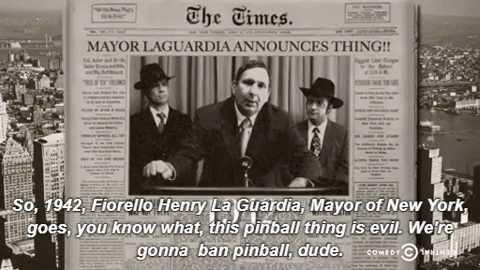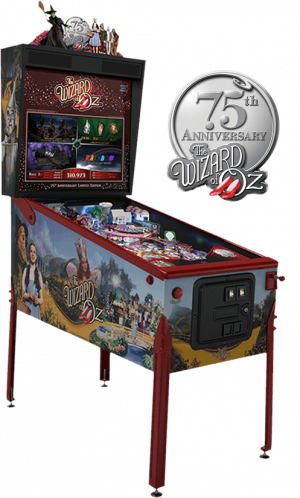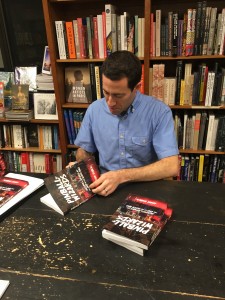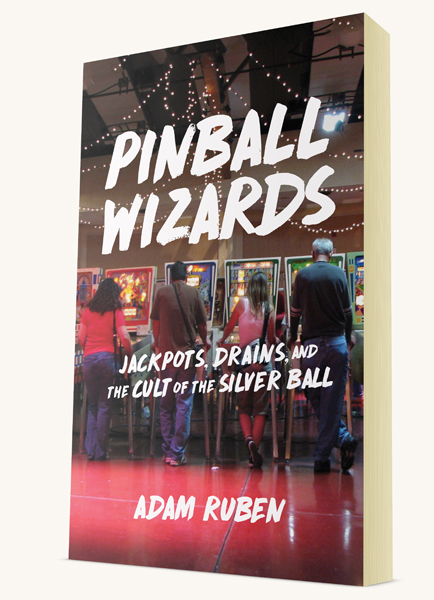 In today’s technology-centered world most people think of pinball as a game from the past. But pinball is the one quintessential arcade game that continues to grow and evolve with the times, reflecting the zeitgeist of every era it passes through and today enjoying yet another renaissance. Pinball Wizards: Jackpots, Drains, and the Cult of the Silver Ball by Adam Ruben is a fun romp through the flashing lights and swirling ramps of a quirky subculture packed with wacky characters.
In today’s technology-centered world most people think of pinball as a game from the past. But pinball is the one quintessential arcade game that continues to grow and evolve with the times, reflecting the zeitgeist of every era it passes through and today enjoying yet another renaissance. Pinball Wizards: Jackpots, Drains, and the Cult of the Silver Ball by Adam Ruben is a fun romp through the flashing lights and swirling ramps of a quirky subculture packed with wacky characters.
Humor writer, comedian and molecular biologist Adam Ruben is a big fan of pinball. He played competitively for more than a decade, rising as high as 80th-ranked player in the world. Then he had kids. Adam fell to 9,938th place, but in his new book, Pinball Wizards, he traces his comeback and discovers what makes the world’s best players, the real wizards, so good.
Adam Ruben discusses how pinball is finding its niche in modern society below.
When and where did you first fall in love with pinball?
I used to play pinball during my family’s annual visit to Rehoboth Beach in southern Delaware. Funland, a great little family-friendly amusement park, had a bank of about 10 pinball machines. (The machines are no longer there, though Funland itself still is.) I started playing competitively in graduate school, when my friend Mike, with whom I used to play Theatre of Magic at a bar across from the campus, learned that pinball leagues exist and paid my way into one as a 24th birthday present. I joined the league, intending to play for just one season, but I stayed for eight years. It was just too much fun to quit.

From Drunk History’s “Pinball Prohibition”
Throughout Pinball Wizards, you argue that pinball’s history is America’s history. Could you explain what you mean by that?
So many of the changes and controversies pinball experienced reflect those of the country at large. In the 1930s, pinball machines were frequently used for gambling purposes until the temperance movement cleaned house and made the games illegal. In the 1960s and ’70s, pinball was synonymous with rebellion—that’s why the Fonz was often seen playing pinball. In the ’80s, pinball joined the arcade craze; arcades were basically showcases of electronic and mechanical technology, and when the craze crashed, pinball lost its momentum. Pinball rose and fell once more in the ’90s, for several reasons, almost disappearing at the end of the millennium when we were all convinced virtual reality was the future and the Internet was flawless. It almost disappeared once more in the 2008–09 financial crisis, but it learned to adapt, and today the organic reinvention of pinball is the result of smaller, craft, boutique manufacturers, reflecting the current “maker” movement.
Why do you think the game has survived to enjoy yet another renaissance?
Four reasons. One, the largest manufacturer of pinball machines, Stern Pinball, made the right decision during the financial crisis: They reexamined their offerings and began pitching their products slightly differently. They held launch parties, kept new titles a well-guarded secret and manufactured three versions of each new game, aimed either at operators who put games into bars, at “rec room buyers” who want a pinball machine in the house, or at connoisseurs, who probably already have 20 pinball machines in the house. These decisions properly capitalized on what buyers want today, which is different from what buyers wanted in 1980.
 Two, the newer startup manufacturers like Jersey Jack Pinball have shown that pinball machines can evolve in major ways. Jersey Jack put a 27-inch screen in the backbox of their first game in 2013, Wizard of Oz, while Stern was still using 1992-era dot matrix displays. Stern has now upgraded their displays as well, and the improvements in technology allow all manufacturers to do things they couldn’t 25 years ago—like, for example, issue code updates for machine owners to add new modes to their games.
Two, the newer startup manufacturers like Jersey Jack Pinball have shown that pinball machines can evolve in major ways. Jersey Jack put a 27-inch screen in the backbox of their first game in 2013, Wizard of Oz, while Stern was still using 1992-era dot matrix displays. Stern has now upgraded their displays as well, and the improvements in technology allow all manufacturers to do things they couldn’t 25 years ago—like, for example, issue code updates for machine owners to add new modes to their games.
Three, we like nostalgia. Just recently, I visited EightyTwo in Los Angeles, a bar with tons of pinball machines and classic video games. It was packed, as it has been every time I’ve gone there. Pinball feels nostalgic, though the nostalgia machines—”I remember playing Twilight Zone!”—now act as gateways to impress players with the awesome new machines nearby.
And four, it’s just a lot of darn fun. I know people who simply don’t care for pinball—my wife, for example, and my mother. But it’s rare to see someone actually grow bored while playing a game.
What was your favorite part of working on Pinball Wizards?
I guess I’m really practicing what I preach, because I’m preaching that pinball is fun, and my favorite part of working on the book was playing lots and lots of pinball. When my kids were born, I had to pull back from pinball—how do I justify a weekend-long trip to Pittsburgh for a competition?—but now I was able to reenter that world for a while.
When you began the research process for the book, did you have an idea of who you wanted to interview? How did you decide?
I contacted my friends, Joe and Julie Schober, a married couple with whom I’ve played in pinball league for many years. I asked them for advice on whom to contact, and they invited me to their house for a barbecue and pinball in their awesome basement arcade. I came away from that evening with a huge list of people I needed to talk to, places I needed to visit and events I needed to attend. It all grew from there.

Ruben signing copies of Pinball Wizards at Politics & Prose
Princeton Alumni Weekly published an excerpt from the book that tells how you came to write the book. Your wife, Marina, said that if you wrote the book, you could play all the pinball you wanted. Now that the book is written, do you think you will compete again?
Actually, I already have. The competitions I played in while writing the book earned me a spot in the DC championships, which took place after the book was finished. Somehow, Marina let me compete in those, and I ended up winning third place in the District. But in order to compete on a regular basis—in, say, a pinball league—I’m going to need to wrap childcare into the bargain. Maybe if I can interest my kids in competing . . . give it a few years . . .
When I’m traveling to speak or perform somewhere, I’ll often look up the local arcades on pinballmap.com and make a quick side trip. I was in Oregon for a couple days in May, and I ended up in two different arcades in Portland, two in Eugene, and one in Salem. And when I have friends visit my home from out of town, I’ll suggest we go play pinball. It often works.
And, when I’m filming for the Science Channel in L.A., I now have a tradition of dragging the crew to a pinball place once filming wraps—usually EightyTwo or AYCE Gogi, which is an all-you-can-eat Korean barbecue restaurant with about two dozen pinball machines.
What do you hope readers take away from Pinball Wizards?
I hope Pinball Wizards will answer the most common question I’ve been asked: “Oh, is pinball still around?” Yes, it’s around, and it’s thriving. There are more than 40,000 registered players in the International Flipper Pinball Association—and those are just the pinball fans who play competitively. There are hundreds of weekly leagues around the world and thousands of competitions each year. I hope those who fondly remember pinball and don’t know its current status will go on pinballmap.com, find a local machine and go play it. The whole concept could have gone extinct in 1942, in 1983, in 1999, and in 2008, but it didn’t. It’s still here, and it’s better than ever.
 “If Chuck Kloseterman and Aziz Ansari wrote a book about pinball together . . . then they still couldn’t top Pinball Wizards. Adam Ruben ricochets you around this strange, zany world and makes you love this timeless game as much as he does.” —Sam Kean, author of The Tale of the Dueling Neurosurgeons and The Disappearing Spoon
“If Chuck Kloseterman and Aziz Ansari wrote a book about pinball together . . . then they still couldn’t top Pinball Wizards. Adam Ruben ricochets you around this strange, zany world and makes you love this timeless game as much as he does.” —Sam Kean, author of The Tale of the Dueling Neurosurgeons and The Disappearing Spoon
“Long before birds were angry or Mario was super, pinball lit up our lives and paved the way for our current cultural obsession. Ruben offers a fascinating and funny peek into our gaming past that will have you reaching for a roll of quarters.” —David Nadelberg, creator, MORTIFIED
“Drawing from his considerable obsession with a game that has inspired generations of loyal players, Ruben plunges readers into this world of boardwalk arcades, bowling alleys, and pinball leagues with a fervor so contagious they may want to run out and join the “cult of the silver ball” themselves.”—Booklist
Pinball Wizards: Jackpots, Drains, and the Cult of the Silver Ball is available wherever books and e-books are sold.
[Order it now $17] [Request a review copy]
No Comments
No comments yet.